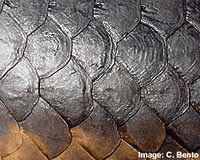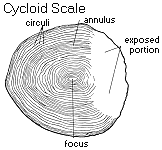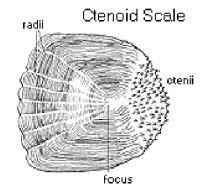
Monday, May 25, 2009
|
|
37th Common
|
|
Join Date: Mar 2006
Posts: 1,514
Thanks: 1,053
Thanked 1,681 Times in 873 Posts
|
|

Scales in Fishes
In most biological nomenclature, a scale (Greek lepid, Latin squama) is a small rigid plate that grows out of an animal's skin to provide protection. In lepidopteran (butterfly and moth) species, scales are plates on the surface of the insect wing, and provide coloration. Scales are quite common and have evolved multiple times with varying structure and function.
Scales are generally classified as part of an organism's integumentary system. There are various types of scales according to shape and to class of animal. Although the meat and organs of some species of fish are edible by humans, the scales are usually not eaten.
Fish scales
Fish scales are dermally derived, specifically in the mesoderm. This fact distinguishes them from reptile scales paleontologically. Genetically, the same genes involved in tooth and hair development in mammals are also involved in scale development.
Cosmoid scales
True cosmoid scales can only be found on the extinct Crossopterygians. The inner layer of the scale is made of lamellar bone. On top of this lies a layer of spongy or vascular bone and then a layer of dentine-like material called cosmine. The upper surface is keratin. The coelacanth has modified cosmoid scales that lack cosmine and are thinner than true cosmoid scales.
Ganoid scales
Ganoid scales can be found on gars (family Lepisosteidae) and bichirs and reedfishes (family Polypteridae). Ganoid scales are similar to cosmoid scales, but a layer of ganoin lies over the cosmine layer and under the enamel. They are diamond-shaped, shiny, and hard.
Placoid scales
Placoid scales are found on cartilaginous fish including sharks. These scales, also called denticles, are similar in structure to teeth.
Leptoid scales
Leptoid scales are found on higher order bony fish and come in two forms, ctenoid and cycloid scales.
As they grow, cycloid and ctenoid scales add concentric layers. The scales of bony fishes are laid so as to overlap in a head-to-tail direction, like roof tiles, allowing a smoother flow of water over the body and therefore reducing drag.
Cycloid scales
Cycloid scales have a smooth outer edge, and are most common on more primitive fish with soft fin rays, such as salmon and carp
Ctenoid scales
Ctenoid scales have a toothed outer edge, and are usually found on more derived fishes with spiny fin rays, such as bass and crappie
Do all fishes have scales?
No. Many species of fishes lack scales. All the clingfishes (family Gobiesocidae) for example, are scaleless. Their bodies are protected by a thick layer of mucous.
Why do fish have scales?
The primary purpose of scales is to give the fish external protection.
How many types of scales are there?
There are four main kinds of scales and numerous variations of each kind. - Placoid
- Cosmoid
- Ganoid
- Cycloid and Ctenoid
Different fishes, different scalation
It is interesting to think about the lifestyle and habitat of a fish, then look at its scales. In the Shark Scale Brain Teaser, the scales of five shark species are shown, two are slow swimming bottom-dwelling sharks, one is a generalist predator, and two are fast swimming pelagic species. Can you work out which scale belongs to each shark?
Are all scales the same size?
No. Scale sizes vary greatly between species. Some fishes, such as the freshwater eels have tiny embedded scales. Fishes such as the tunas have tiny scales often found in discrete areas of the body. Many fishes such as the Coral Snappers have medium sized scales whereas the scales of others such as the Tarpon, Megalops cyprinoides are large enough to be used in jewelery. The scales of the Indian Mahseer, Tor tor are known to reach over 10 cm in length.
How old is a fish scale?
As cycloid and ctenoid scales increase in size, growth rings called circuli become visible. These rings look a little like the growth rings in the trunk of a tree. During the cooler months of the year the scale (and otoliths) grows more slowly and the circuli are closer together leaving a band called an annulus. By counting the annuli it is possible estimate the age of the fish. This technique is extensively used by fisheries biologists.
Can a fish have more than one type of scale?
Yes. Some species of flatfishes (flounders, soles, etc) have ctenoid scales on the eyed side of the body and cycloid scales on the blind side.
Can scale type vary with sex?
Yes. In some species of flatfishes, males have ctenoid scales and females have cycloid scales.
Functions
Protection from predators.
Placoid Scales
Ganoid Scales

Cycloid Scales

Ctenoid Scales

Last edited by Viceroy; Monday, May 25, 2009 at 12:01 PM.
Reason: Merger
|